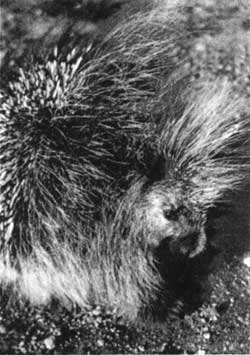|
Volume XX - 1954
Porcupine Encounters
By John Mees, Ranger Naturalist
The yellow-haired porcupine, Erethizon dorsatum epixanthum
Brandt, is frequently seen waddling slowly beside our park highways,
especially at night. When in a hurry, however, this fellow can ramble
along at about two to three miles an hour. This speed was estimated by
clocking a porcupine from an automobile while I was traveling the Rim
Drive near Dutton Ridge. The porcupine was held on the highway by the
stone retaining wall, thus providing a good opportunity to time him
while he was moving in a fairly straight line.
It is often said that a porcupine is an animated bundle of quills.
He is armed with twenty to thirty thousand of these barbed needles which
form his main, and almost only, means of defense. This equipment is
adequate for protection against the great majority of enemies. An
interesting correlation with low birth rate can be found here, for
porcupines are almost always born singly. A rare occurrence of twins is
suggested by the observation of an adult with two youngsters in the
Castle Crest area during July, 1947, by Ranger-Naturalist Gordon P.
Walker (Walks, 1947).
A vigorous slap by the porcupine with his powerful tail can send
quills well into the nose and face of any animal inexperienced in
dealing with these creatures. I have observed several small porcupines
along Dutton Ridge and they have invariably kept their tail between
themselves ant me when they were cornered.
A few natural enemies of the porcupine become expert at killing them
without picking up a collection of quills. The porcupine is usually
forced into a corner and snatched by the nose. With a quick flip it is
turned onto its back and then attacked at the soft, unprotected
underparts.

Yellow-haried Porcupine
From Kodachrome by Richard M. Brown
|
Early in the summer of 1952, two hollow porcupine "shells,"
consisting of nothing but fur and quills, were found near Castle Crest.
Proof as to the identity of the animals that had killed them could not
be found, but bear tracks were seen in the snow around the carcasses.
Since numerous bears were seen in the same area at various times, it
seems quite possible that these animals were responsible for the fatal
encounter. A similar skin was found in the Castle Crest Wild Flower
Garden in the early spring of 1946 (Wallis, 1947).
During the month of July, 1953, I was so surprised by a porcupine
along the banks of Sand Creek that I nearly lost my footing, which would
have meant a sudden dip in the creek. Luckily only the porcupine slid
down the loose talus slope into the stream. This porcupine apparently
disliked swimming and refused to swim across the stream. Instead, he
floated along with the current until he was able to climb back onto the
same bank. Wallis (1947) reports having met a porcupine while walking on
the stream bank in the steep canyon of Patton Creek. This particular
animal, upon being disturbed, plunged into the water and seemed to cross
to the other side with no trouble at all.
Episodes such as these with porcupines make the study of our local
inhabitants an absorbing experience. With a little patience, you also
will surely have interesting encounters during your stay in the Park.
And perhaps you will learn some new and unusual feature of the wildlife
in the park.
References
Cahalane, Victor H. 1947. Mammals of North America. MacMillan
Co., New York. x, 682 pp.
Sumner, Lowell and Joseph S. Dixon. 1953. Birds and Mammals of
the Sierra Nevada. University of California Press, Berkeley. xvii,
484 pp.
Wallis, Orthello L. 1947. A Study of the Mammals of Crater Lake
National Park. Unpublished Master's thesis, Oregon State College,
Corvallis. 91 pp.
Two New Bird Records
By Robert C. Wood, Ranger Naturalist
On the morning of August 22, 1954, while leading a field trip along
the lower part of the Garfield Peak Trail, I first heard and then saw an
adult male goldfinch, Spinus tristis (Linnaeus). The bird was in
bright yellow plumage and was at a distance of between fifty and one
hundred feet as it fed on the ground and made several short flights.
The other, more spectacular, observation was made on the afternoon
of September 3, 1954. While on duty at Sinnott Memorial, I observed a
bird of unusual appearance circling over the lake shore directly in
front of and below that observation point. It continued to soar, with
some flapping of its wings, above the shore of the lake between Sinnott
Memorial and the foot of the lake trail until it was high overhead. It
then glided off in a southward direction.
I believe the bird to have been a jaeger, a pelagic bird seen
infrequently along the coast and only rarely inland. It was quite dark
above, white below, and had a noticeable black cap. The most striking
features of the bird were its elongated central tail feathers and its
long, tapering, pointed wings. The shape of the tail feathers indicate
that the bird was either a parasitic jaeger, Stercorarius
parasiticus (Linnaeus), or a long-tailed jaeger, S.
Iongicaudus (Vieillot); its trim appearance and graceful flight
would seem to indicate the latter bird.
The jaeger was observed with eight-power binoculars in good light
for about five minutes.
Reference
Farner, Donald S. 1952. The Birds of Crater Lake National
Park. Lawrence, University of Kansas Press. xi, 187 pp.
| 
